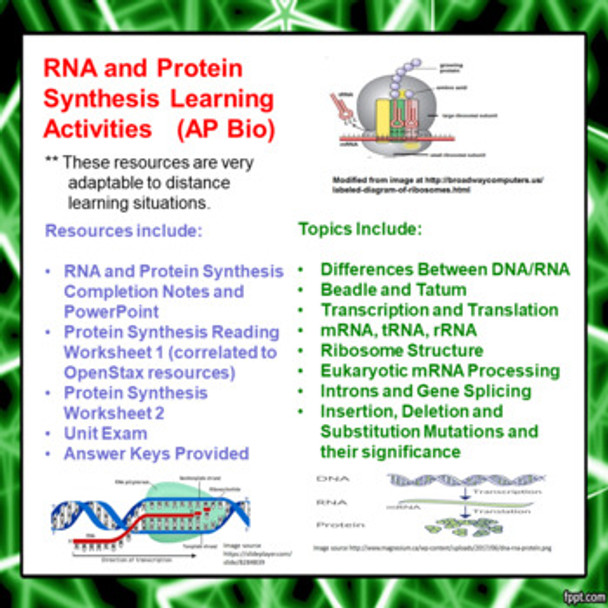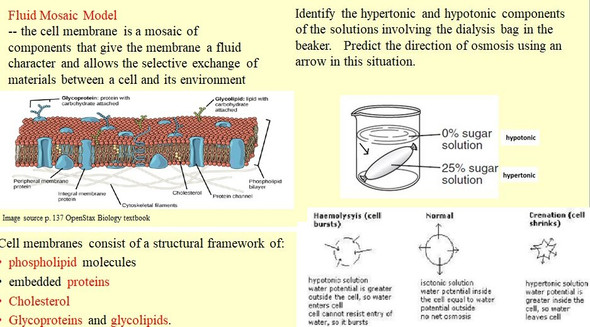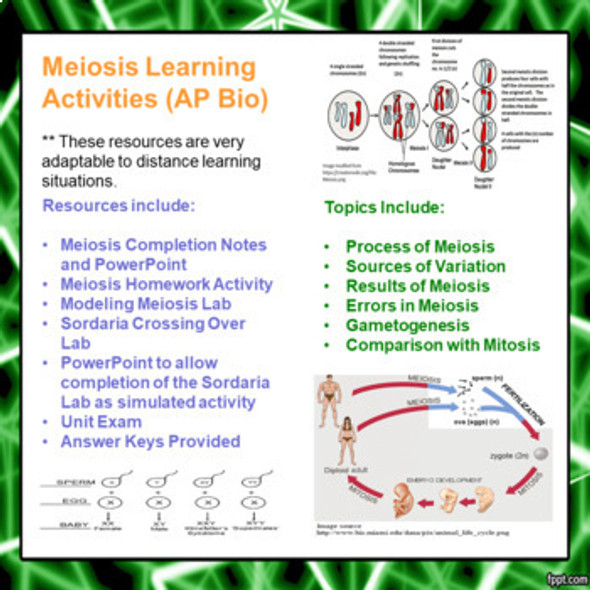RNA and Protein Synthesis Learning Activities for AP Biology (Distance Learning)
- Bulk Pricing:
- Buy in bulk and save
- James Buckley:
- Monday's Rescue
- Grade 12:
- Grades 10-12
- Learning Package (PowerPoint, Notes, Quiz, Reading Worksheet, Learning Objectives):
- PDF, DOC, PPT
- Pages:
- 27
- Answer Key:
- Yes
Description
This product is contained in a zip file with many activities (27 pages of student handouts and a PowerPoint with a total of (37 slides) which can be used to compose a unit for AP Biology or advanced Biology students on RNA Structure and Protein Synthesis. Concepts discussed and evaluated include discussion of mRNA, tRNA, rRNA as well as the concepts of transcription and translation. The Beadle and Tatum hypothesis and specifics regarding the process of protein synthesis are presented. RNA processing is also discussed.
The file contains two homework assignments and a comprehensive examination and key on these topics. Completion notes and the accompanying PowerPoint are included. Links to other animations and lab resources are also present. The learning guides/assignments contain links to online resources to support student learning.
This lesson packet contains a listing of the learning goals, common core learning standards, NGSS learning standards and the AP Biology performance indicators addressed in these materials. These are included in the packet and at the end of the description of this lesson.
Most documents are included in both word doc or docx as well as pdf format to allow editing for specific teacher needs. These learning materials are well suited for a distance learning situation.
Answer keys are included for all activities. All documents with the exception of the PowerPoint are included in both word (to allow you to easily edit the document to suit your needs) and pdf format.
The specific contents of the learning package includes the following items (the page count for these items are actual student handouts as answer key page counts are not included):
-- RNA and Protein Synthesis Objectives including ETS, NGSS and Common Core standards (2 pages) in word and pdf format
-- RNA and Protein Synthesis Completion Cloze notes (10 pages) in word and pdf format
-- PowerPoint to accompany the RNA and Protein Synthesis Completion notes (36 slides)
-- Protein Synthesis Worksheet # 1 with Key (18 short answer questions) in word and pdf (1 page/3 page key)
-- Protein Synthesis Worksheet # 2 with Key (38 mixed format questions) in word and pdf format (5 pages)
-- RNA and Protein Synthesis Test with Key (40 mixed format questions) in word and pdf format (7 pages)
ETS AP Biology Learning Objectives
Enduring Understanding
IST-1 Heritable information provides for continuity of life.
Learning Objectives
IST-1.A Describe the structural similarities and differences between DNA and RNA.
IST-1.N Describe the mechanisms by which genetic information flows from DNA to RNA to protein.
IST-1.O Describe how the phenotype of an organism is determined by its genotype.
Student Learning Goals
Upon the completion of this unit the student will be able to:
1. describe Beadle and Tatum's experiments with Neurospora, and explain the contribution they made to our understanding of how genes control metabolism.
2. distinguish between "one gene—one enzyme" hypothesis and "one gene—one polypeptide," and recognize the original hypothesis was changed.
3. explain how RNA differs from DNA.
4. briefly explain how information flows from the coding section of a gene to protein.
5. distinguish between transcription and translation.
6. define the terms codon and anticodon, and explain what relationship exists between the linear sequence of codons on mRNA and the linear sequence of amino acids in a polypeptide.
7. recognize the importance of the three stop codons and the one start codon.
8. explain the evolutionary significance of a nearly universal genetic code.
9. discuss the process of transcription including the three major steps of initiation, elongation, and termination.
10. describe the general role of RNA polymerase in transcription.
11. distinguish among mRNA, tRNA, and rRNA.
12. describe the structure of tRNA and explain how the structure is related to function.
13. given a sequence of bases in DNA, predict the corresponding codons transcribed on mRNA and the corresponding anticodons of tRNA.
14. describe the structure of a ribosome
15. explain how eukaryotic mRNA is processed before it leaves the nucleus.
16. describe some biological functions of introns and gene splicing.
17. explain why base-pair insertions or deletions usually have a greater effect than base-pair substitutions.
18. explain what is meant by RNA processing.
NGSS Standard
Students who demonstrate understanding can:
HS-LS1-1. Construct an explanation based on evidence for how the structure of DNA determines the structure of proteins which carry out the essential functions of life through systems of specialized cells.
Common Core State Standards Connections:
ELA/Literacy
RST.11-12.1 Cite specific textual evidence to support analysis of science and technical texts, attending to important distinctions the author makes and to any gaps or inconsistencies in the account.
WHST.9-12.2 Write informative/explanatory texts, including the narration of historical events, scientific procedures/ experiments, or technical processes.
WHST.9-12.9 Draw evidence from informational texts to support analysis, reflection, and research.
Terms of Use
Purchase of the product is for classroom use by the purchaser only. It is a violation for individuals, schools, and districts to redistribute, sell, or post this item on the Internet or to other individuals.
This work is licensed under a Creative Commons Attribution-NonCommercial-ShareAlike 4.0 International License.
This learning package bundle is part of the AP Biology Complete Course. The complete course contains 22 learning package bundles in addition to this one. Save nearly 60% over the cost of buying 23 individual unit learning bundles with your purchase of the complete course.
Check out Monday's Rescue for more great resources!














